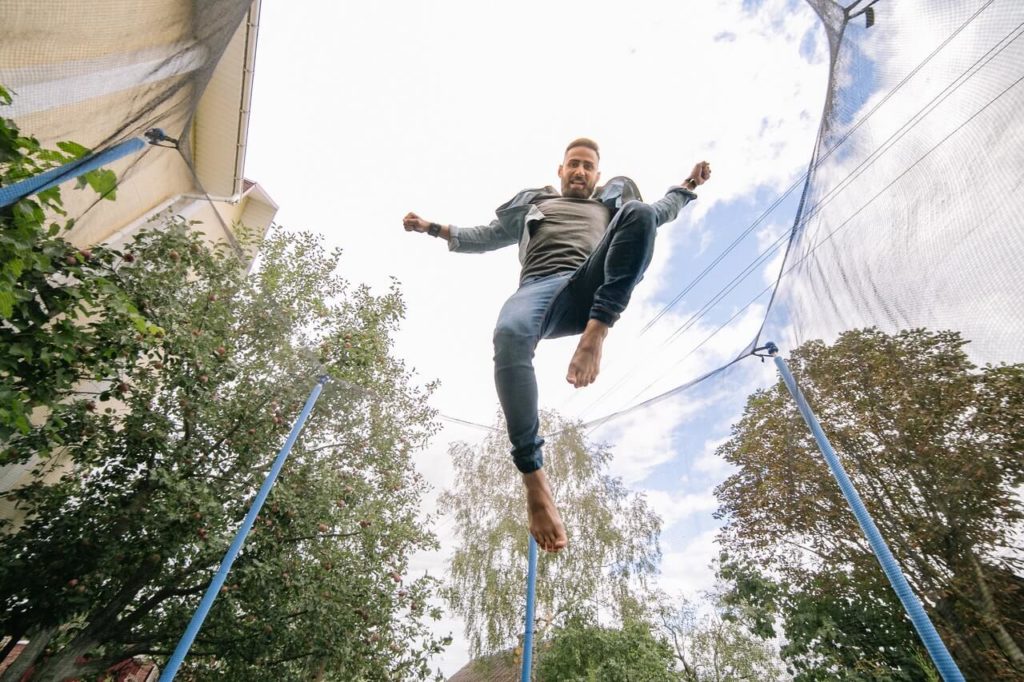Do you want to learn how to do a backflip on a trampoline and what it takes to make a successful backflip?
If you are conversant with the front flip, a backflip won’t take long to master. Even beginners shouldn’t worry about it.
The best part is anyone can learn to backflip on a trampoline and exercise this cool trick whenever they feel bored.
Let’s check some tips and steps to implement when doing a backflip on a trampoline.
Keep reading
How to Do a Backflip On a Trampoline in 9 Easy Steps
1. Get Prepared

Before engaging in a backflip, remember that this is a new concept you are introducing to your body, and it may take time for the body to get used to it.
One way to prepare is by getting a working partner and, to be precise, someone who is good at backflipping. Getting hurt on your first backflip is possible, and a good partner will help you avoid this by spotting and correcting any wrong moves.
Get someone you feel comfortable working with and ask for their help when you try to rotate on the trampoline. Your partner can place their hand on your back to help you lift your feet when flipping.
If you feel comfortable being on the trampoline alone, you can ask your partner to stand nearby and watch from a distance and be prepared to act if something comes up.
2. Warm-Up

If you can’t get on the trampoline and start your backflip, better start with some tuck jumps, stretching the muscles, or straddle jumps. The warm-up will help you feel the trampoline material and bounce.
Trampolines are different, and you should ensure that you are familiar with the one you are working with, plus ensure it’s well-fixed and doesn’t have weak parts to prevent falling and unsafe landing.
3. Do a Backdrop
After the warmup, you can move to a backdrop where you fall with your back and bounce back.
For an easy backdrop, start with a seat drop and go back ways until you are comfortable throwing your legs for a simple somersault.
Lift your legs slowly and throw them behind you; start bouncing back and rotating behind onto your knees, and with time you will gain the backward momentum for easier backflipping.
4. Start With an Over the Shoulder Handspring
When you are done with backdrops, your body will be flexible to start flipping. Start with a sideways handspring which will create more momentum than the backdrop. The handspring isn’t scary, and it helps you learn sideways movement. Follow these steps for a successful sideway handspring.
Bend your hands at the elbows and move them over your head, going backward circularly. It would be best if you had this motion in your jumps.
Keep looking over your shoulder, and the neck will bring along your whole body plus, this way, you will place your jump strategically. Bounce and make a straight jump.
When at the peak of your jump, try and roll over your shoulder as you aim to land on your arms. Even landing on the knees is a great achievement. And another thing, don’t strain your hands in the first days of learning.
5. Get a Regular Back Handspring
I believe that an over-the-shoulder handspring will help you build momentum for a full back handspring where you will move from looking behind your shoulder and switch to looking up.
Additionally, you need a lot of air to keep up with this move. Ensure you don’t focus too much on propelling backward without adjusting your position on the trampoline to avoid falling off.
Start your handspring near the trampoline’s center and focus on jumping up, then turn to avoid injuring yourself with a backward move.
6. Repeat the Move
Getting your feet and hands on the same plane is not easy, but you will learn faster if you continue with the regular handspring. Remember to throw the hips in a wide rotation. It gives you momentum, and your hips and abs will release the power for a better backflip.
Tucking your hands and legs adds momentum. Adapt the technique of an ice skater who wants to increase speed, and you will increase the surface area for flipping.
7. More Practice

I am sure you want to achieve the best backflip on your trampoline as soon as possible, and to make it, you need to jump higher every time. Keep pushing harder, bend your knees and remember to locate the trampoline with your eyes.
Let’s be honest, over-flipping might occur during your first days of flipping, but you shouldn’t worry much about it. Get on with your practice and believe in yourself, and soon you will have the best flips.
If your body can’t do it today, stop and try again tomorrow to avoid frustrations. Don’t break your neck trying to achieve a lot within a short time. Be patient and practice.
8. Adjust the Position

When familiar with the flip, you need to adjust your position for better performance. Look backward and ensure you can see the floor behind you. Plus, it would help if you weren’t diagonal to the side.
Give enough room from the center to allow a wider jumping area. Allow your instincts to take over when finding the right position. Don’t forget the upward to over technique, and it will help you have a large bounce for a successful backflip.
9. Do the Full Backflip
A full backflip involves landing on your feet with your hands keeping steady to protect your neck from injury. When flipping, ensure you carry most of your weight to land on your feet.
Landing is a matter of time, and the main aim at this point is carrying your body when using your hands to propel up and in a circular way. Please ensure that you don’t hurt yourself.
Everyone has their way of flipping, and all that matters is mastering the art. Positive thinking will help in building your momentum. Make sure you aren’t forcing any steps and if you are not ready, give yourself time.
Safety Tips to Observe for a Successful Backflip
Be cautious when learning how to backflip on a trampoline to avoid accidents and injuries.
First, you can get a coach to help you in training.
Don’t move your hands downwards if you don’t complete a rotation, keep the frog position to avoid breaking your hands.
A small trampoline works well for beginners, and it will help you avoid injuries when flipping backward. However, if you got an instructor, you can get a wider trampoline to avoid falling.
Lastly, don’t force a flip; try again after some practice if it is not coming.
How Do I Get Over Fear When Doing a Backflip as a Beginner?

At first, you may find it hard to go on with the flip, but you will get through with practice. Start by familiarizing yourself with the trampoline through some regular jumps.
Master the basic skills like back roll, backdrop, and front flips to build your confidence before trying the backflips. Additionally, exercise regularly and focus on practices that free your body, and you can easily backflip and have a soft landing.
How Do I Backflip on a Small Trampoline?
Trampolines come in different sizes, and you may see one that discourages you from flipping. However, the size shouldn’t matter if you are determined to master the art with proper timing and soft landing. The feeling is similar in all trampolines. Ensure that your trampoline is well set up and the net is tight just in case you land in the wrong area.
How Do You Do a Backflip for Beginners on a Trampoline for Kids?

If your kids love backflips and you are wondering when to introduce them, the right time is now. The good news is that kids are more flexible, and it may take less time to master backflipping.
You should be a very keen instructor to your kids and start by introducing simple techniques to more advanced ones. Take a step further and introduce backflips and remember they can make mistakes, so don’t be too hard on them.
How Do you Do a Tuck Backflip on a Trampoline?
First, get comfortable on the trampoline and begin with back jumps. Bending your knees is a good way to prepare for the tuck. A stack of pillows will help until you feel comfortable. Remove the pillows and do your back tuck.
Can I Hurt My Neck When Doing a Backflip on a Trampoline?

Neck injury is common in backflips, and you need to be cautious. Remember, when jumping on a trampoline, your head quickly moves forward and backward when landing on your back which may snap the neck bone (the occurrence is rare).
Jumping at the center and allowing only one person on the trampoline are some safety tips to avoid neck injury. Never forget to install a safety net to avoid other serious injuries and falling.
Final Thoughts
When doing backflips, a safe landing is very important in preventing injuries. Never force your body to flip when it doesn’t feel like it. Flipping is fun, and any physically fit person can engage in it. Once you master the basics of flipping, you can train other interested people. Remove your jewelry when getting into the trampoline. Shoes aren’t necessary, but get a pair with a proper grip if you must have them. All the best in your backflips.







